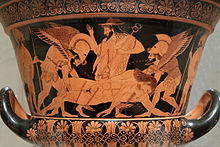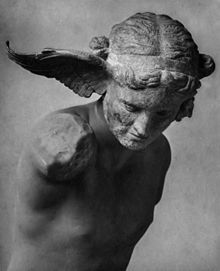Hypnos
![]()
The title of this article is ambiguous. For other meanings, see Hypnos (disambiguation).
![]()
Somnus is a redirect to this article. For the celestial body see Somnus (moon).
Hypnos (Greek Ὕπνος Hýpnos, German 'sleep') is a deity of Greek mythology. He is commonly regarded as the god of sleep. His Roman counterpart is Somnus.
Hypnos is one of the chthonic gods (pertaining to death and life or the subterranean gods) and therefore bears the epithet Chthonios. Another epithet, according to Pausanias, is Epidotes (Ἐπιδότης Epidótēs, German 'the giver, the generous'). Homeric epithets are Hypnos nedymos (νήδυμος Ὕπνος nḗdymos Hýpnos, German 'the lovely, sweet, enveloping sleep') and Pandamator (πανδαμάτωρ pandamátōr, German 'the all-captivating one').
Since Hypnos was said to have the ability to put gods and men into deep sleep, the term hypnosis was derived from his name.

Hypnos and Thanatos carrying the body of Sarpedon. Attic red-figure goblet crater. Euxitheos (potter), Euphronios (painter), c. 515 BC.
Description
According to Hesiod's Theogony, Nyx, the Night, brought him forth fatherless; his brother is Thanatos, Death. According to Hesiod, the Oneiroi, the gods of dreams, are brothers of Hypnos. According to later mythological tradition, he is the son of Nyx and Erebos, the Darkness.
Hypnos and Thanatos reside in the underworld (Hades). However, different specifications are in play to specify the place of residence. Erebos and Tartarus, two other parts of the Greek underworld, are also given as the place of residence. In the Theogony, the dwelling place is said to be the House of Night, that of Mother Nyx. The house forms an entrance to Tartarus and is said to lie far to the west. Day and night are said to meet there. According to Ovid, Hypnos dwells in a cave through which flows the river Lethe ("forgetfulness"). This is near the land of the Cimmerians. His bed is made of ebony and in front of the entrance of the cave grow herbs with soporific effects. No light or sound penetrates the grotto. Mist and dawning darkness surround the realm ("Cimmerian darkness"). According to Homer he lives on the island of Lemnos, which was therefore later called his own dream island by other authors. According to Statius he lives in the west, in Aithiopia. The realm of Hypnos is also said to be guarded by the goddesses or daimones Aergia ("leisure"), Hesychia ("rest") and Lethe ("oblivion"). The charis Pasithea is named as his consort. His children Morpheus ("shape"), Phobetor ("terror") and Phantasos ("imagination, fantasy") are the gods of dreams. However, he is said to have far more children who are also Oneiroi. According to Ovid, he is considered a calm and gentle god who helps people with their needs and possesses half of their lives as sleep.
In the visual arts, Hypnos is often depicted as a sleeping youth garlanded with opium poppy blossoms, sometimes as an aged and languid man with bird wings, again more often as a graceful young man with butterfly wings over his temples or on his shoulders. His other attributes include a cornucopia in his right hand, filled with dreams or sleep, and a poppy branch (or a branch which has been dipped in the river Lethe) in his left. An inverted (extinguished) torch is also counted among his attributes, as well as those of his brother Thanatos. Statue portraits show Hypnos either alone or with his brother Thanatos. He is frequently depicted on sarcophagi. According to Pausanias' description of Greece, Thanatos and Hypnos are pictured on a box at Olympia. In it, the goddess Nyx carries a white boy on her right arm and a black boy on her left arm. Both are shown asleep and with bent feet and crossed legs respectively. Which boy exactly is Hypnos can only be assumed. In Nonnos' Dionysiaka the god of sleep is described by Aphrodite as dark-skinned, while his wife Pasithea is described as lily-white or snow-white. He is also described as black-winged.
Hypnos was worshipped in only a few places, often in connection with Asclepius; so also in Sikyon in a temple of Asclepius. With his epithet Epidotes he appears in a painting, putting a lion to sleep. A statue is said to have existed there also. At Troizen in the Argolis he was worshipped with the Muses, described as good friends. Another statue was found at Sparta. In the British Museum the bronze head of Hypnos is exhibited; in the Museo del Prado is a statuette in marble. Lessing sees in the Ildefonso group an embodiment of Hypnos and Thanatos.

Bronze head of Hypnos (torso reconstructed in a modern way)

Hypnos on the tomb of Alexander von der Mark, created by Johann Gottfried Schadow 1788
Myth
According to Greek mythology, Hypnos has the power to put all gods, men and animals into a deep sleep. According to legend, Hypnos fell in love with the young man Endymion because of his beautiful eyes. In order to be able to admire them at all times, Hypnos enchanted the sleeping man so that his eyes would remain open even in sleep. A variant of this tale describes Endymion as the lover of the moon goddess Selene: Hypnos gave him the ability to sleep with his eyes open so that Endymion could look at the moon goddess even at night.
Another legend reports that the goddess Hera asked Hypnos to put Zeus, the father of the gods, into a deep sleep so that he would not notice when she asked the sea god Poseidon for help in the battle for Troy. The sleeping god refused a golden throne created by Hephaestus. He only agreed when Hera promised him Pasithea as a wife in return. Hypnos made Hera swear on the river Styx, for he feared the wrath of Zeus. Hypnos had already put Zeus to sleep once. That had also been at Hera's request, who wanted to hunt Heracles undisturbed. When the father of the gods woke up and found this out, he became furious. He pursued Hypnos, who fled to his mother Nyx. There the pursuit ended by the father of the gods, who preferred not to mess with the night. The next time Hypnos turned into a night bird and flew to Mount Ida. After Hera distracted Zeus, Hypnos put him into deep sleep a second time. He then relayed Hera's request to Poseidon. And this time Zeus did not find out that the god of sleep was behind it. In the Dionysiaka, a scene analogous to the Iliad is described.
During the Trojan War, Zeus orders Hypnos and his brother Thanatos to take the body of his son Sarpedon to Lycia for burial.
According to another request of Hera (Juno), Hypnos is to teach Alkyone the death of her husband at sea. The god of sleep passes this order on to his son Morpheus, since the latter is a god of dreams and can take possession of all human forms in dreams. The message is delivered by Iris; Ovid makes it clear that she too can hardly escape the soporific power of Hypnos.
Hypnos, who was friendly to people, also fulfilled requests from heroes. The Colchian princess and granddaughter of Helios, Medea, needed Hypnos' help. She called upon the sleep god to put the never-sleeping dragon and guardian of the Golden Fleece to sleep. With Hypnos' help, Medea was successful, and Iason took the fleece. Athenian vase paintings show Hypnos alongside the giants Alkyoneus and Heracles. Since Alkyoneus could not be killed in his home, Heracles had to carry him out of Pallene. The depiction of Alkyoneus as sleeping suggests that Hypnos put the giant to sleep and Heracles then carried him away.
Search within the encyclopedia